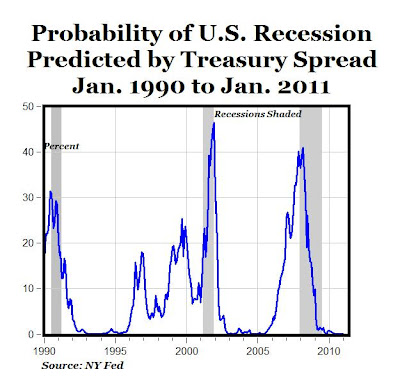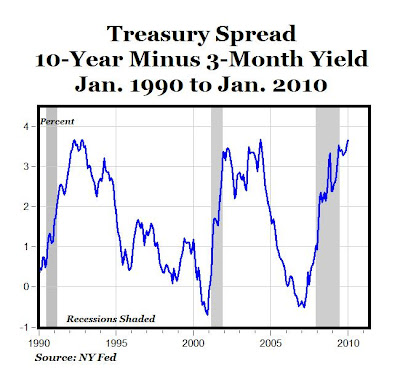NY Fed Treasury Spread Model: Probability of Recession Falls to Lowest Level Since 1983

 Today the New York Federal Reserve updated its "Probability of U.S. Recession Predicted by Treasury Spread" with data through January 2010, and the Fed's recession probability forecast through January 2011 (see top chart above). The NY Fed's model uses the spread between 10-year and 3-month Treasury rates (3.67% spread in January, the highest since May 2004) to calculate the probability of a recession in the U.S. twelve months ahead (see details here).
Today the New York Federal Reserve updated its "Probability of U.S. Recession Predicted by Treasury Spread" with data through January 2010, and the Fed's recession probability forecast through January 2011 (see top chart above). The NY Fed's model uses the spread between 10-year and 3-month Treasury rates (3.67% spread in January, the highest since May 2004) to calculate the probability of a recession in the U.S. twelve months ahead (see details here).The Fed's model (data here) shows that the recession probability peaked during the October 2007 to April 2008 period at around 35-40%, and has been declining since then in almost every month. For January 2010, the recession probability is only 0.82% (less than 1%) and by a year from now in January 2011 the recession probability is only .043%, the lowest reading in more than 26 years (since September 1983).
Further, the Treasury spread has been above 3% for the last nine months (since May), a pattern consistent with the economic recoveries following the last two recessions (see bottom chart above), and the 3.67% spread in December is the highest since May 2004, five-and-a-half years ago. Finally, the pattern of the recession probability index last year (going below double-digits and declining monthly) is very similar to the patterns that signalled the end of the 1990-1991 and 2001 recessions.
According to the NY Fed model, the chances of a double-dip recession in 2010 or 2011? Zero.

14 Comments:
To what extent has this model been accurate (or not) in the past?
Or, can it predict the past?
Svend: See details at the link provided, I just added it to the post.
So this recession probability won't be affected by the supposed accumulated debt?
has this model ever been tested in an American balance Sheet recession?
High unemployment expected for years to come? Another jobless recovery? The 'real' unemployment rate a few percentage points higher than the official? Whoo-hoo! Happy days are here again!
it seems to me that there are some pretty good reasons to suspect that the signal from this model does not currently mean what it usually means.
never before has there been "quantitative easing" of this sort, especially in conjunction with tightening tier one ratios.
this powerful combination of banks holding more treasuries and the fed supporting pricing by purchasing huge chunks of the bond auctions is distorting bond prices very significantly (and deliberately).
add to this the tailwind of japan and chine desperately trying to hold down their currencies and you have a bond market that is no longer just looking at growth and inflation.
if bond prices are meaningfully distorted (and i would argue that they are), then this model's signal is less reliable and possibly meaningless.
Of course, the probability of a recession is low, because we're at the beginning of an expansion. The question should be how will the new U.S. economy look like?
We're on the verge of net job creation, after losing 8 1/2 million jobs in two years, and another 1 1/2 million jobs are needed each year just to keep up with population growth. However, job growth will likely be too weak to raise employment much for at least two years.
Anyway, I see the cost of living rising through higher prices, less capital creation, and more taxes. The U.S. economy will likely become much more inefficient. U.S. living standards may actually decline, substantially, over the next decade.
Demographics are one bright spot. The Baby-Boomers may remain most productive for another decade, because retirements will be postponed, which will add to economic growth.
I originally heard this on the radio. It seems cat stew was a delicacy during the Great Depression:
Cooking Show Host Fired for Recommending Cat Stew
Feb 19th 2010
Beppe Bigazzi, a well-known food writer, was fired from the cooking show "La Prova del Cuoco" after telling viewers that stewed cat is a "succulent dish," the Times of London reports.
"I've eaten it myself and it's a lot better than many other animals. Better than chicken, rabbit or pigeon," the 77-year-old Bigazzi told viewers.
The show's presenter Elisa Isoardi, who mentioned her own cat Othello in protest, looked awkwardly horrified as Bigazzi explained that cat meat should be soaked in spring water for three days before cooking.
The show's producers are to be investigated for criminal offenses for inciting the mistreatment of animals, the Times reported.
With stray cats being euthanized by the millions, is it really so shocking to suggest eating a few here and there?
Sure, if the government keeps borrowing and spending money then GDP will rise. It's not necessarily because of an increase in employment, it's simply a matter of government spending.
I project that if the government continues to borrow and spend trillions of dollars then GDP will rise.
I also predict that if the government continues to do that, then future production will be severely muted by the debt load thrust upon us by a fiscally irresponsible federal government.
There is no free lunch. An increase in GDP does not make for a better life. An increase in GDP does not make for lower unemployment.
James
"Sure, if the government keeps borrowing and spending money then GDP will rise"...
Hmmm, is that sort of the same as inflating our way out of debt?
this sure doesn't look like a "V" recovery to me...
WASHINGTON (AP) -- Sales of new homes plunged to a record low in January, underscoring the formidable challenges facing the housing industry as it tries to recover from the worst slump in decades.
The Commerce Department reported Wednesday that new home sales dropped 11.2 percent last month to a seasonally adjusted annual sales pace of 309,000 units, the lowest level on records going back nearly a half century. The big drop was a surprise to economists who had expected sales would rise about 5 percent over December's pace.
The January decline will heighten fears about the fledgling recovery in housing. Economists were already worried that an improvement in sales in the second half of last year could falter as various government support programs are withdrawn.
The sales decline in January marked the third straight monthly drop following decreases of 3.9 percent in December and 9.5 percent in November.
January's weakness was evident in all regions except the Midwest, where sales posted a 2.1 percent increase. Sales were down 35 percent in the Northeast, 12 percent in the West and almost 10 percent in the South.
The drop in sales pushed the median sales price down to $203.500. That was down 5.6 percent from December's median sales price of $215,600, and off 2.4 percent from year-ago prices.
There is an old joke among certain social workers, along the lines of "when you are feeling suicidal is a terrible time to kill yourself."
So it is with economic outlooks. At the bottom of a recession is a terrible time to take stock of the future. You will be gloomy.
At the bottom of the past several recessions there were naysayers to the effect that the good times are over forever.
At the top of each boom are pundits exulting in Pax Americana, free enterprise and the Golden New Age of Technology to the Moon.
The recession is over. I suspect we have a long pull out.
A huge positive compared to 30 years ago is the enormous amount of investment capital the globe generates every year, the global venture capital community and private equty funds etc galore.
Productivity everywhere is rising all the time. Crop yields are going up, and we may be on the cusp of breaking forever the tyranny of liquid fuels through the commercialization of the plug-in electric vehicle, or PHEV.
The biggest threat to our future is Red Ink Republicans, Red State Socialists and Deficit Democrats.
Public debt as share of GDP did decline in the 1990s. We can do it again.
The probability of a recession in 2010 is 1 because we are still in one.
GDP and industrial production were artificially and temporarily inflated by massive government spending and inventory adjustments. Nonfarm job growth is still declining. Personal income net of transfers is flat.
Nope, the coincident indicators do not indicate a recovery yet.
Within a positive environment of institutional stability and technological advances, the degree of individual willingness and abilities is what ultimately facilitates the more productive use of economic resources and the accumulation of capital necessary for future economic growth and if the government continues to borrow and spend trillions of dollars then GDP will rise.
Post a Comment
<< Home